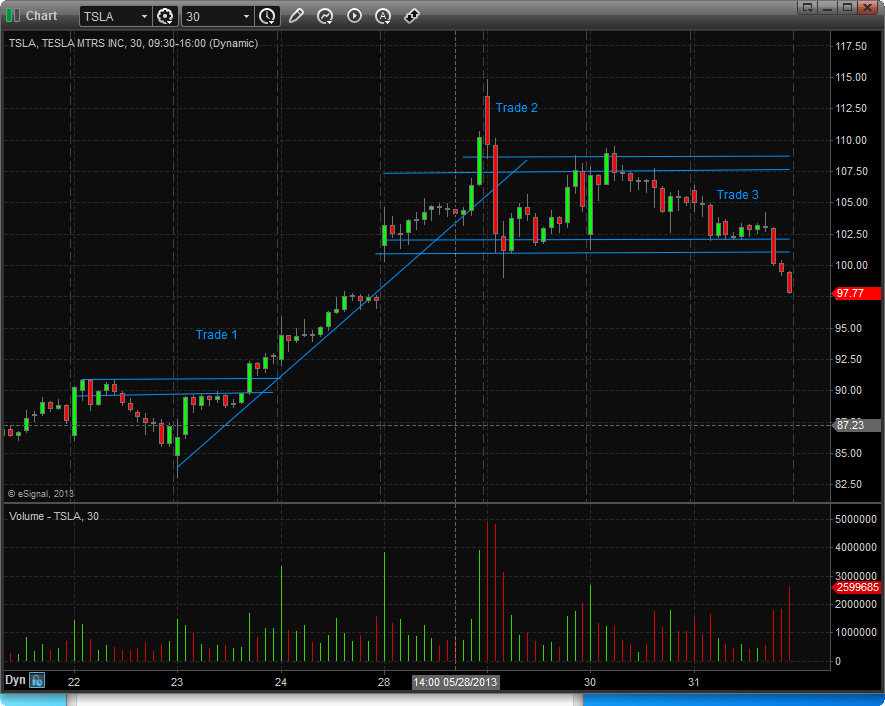(This post was written on June 1, 2013)
The price action in $TSLA from the past six trading days does a nice job of demonstrating three distinct types of trades. Not all trades makes sense to all traders. But if as a trader you can figure out which of these trades fits your personality best and then build a detailed trading plan on how to attack it, next time it occurs you can start to improve your consistency. Most of the experienced traders Bella and I have interviewed over the years who are struggling do not have a well defined playbook and this is the primary cause of their widely varied results.
Trade 1: May 23 — Consolidation Break Swing Trade. After three hours of consolidation TSLA breaks above its morning high of 90 and in the same candle takes out the prior day’s high as well. This is what is known as a “break of consolidation” with momentum and volume. This is where many swing traders entered long positions in TSLA looking for a move above the post earnings high. The exit occurred on Day 4 on the large gap up in the pre-market. This pattern generally appeals to trend followers who are more patient and willing to hold a position for a longer period of time. The trade almost always ends on the Open of the 3rd or 4th trading day with a large gap higher that is unsustainable and leads to Trade 2. To understand that this pattern repeats itself in momo stocks look at TSLA’s behavior following their earnings release. On Day 4 it gapped higher and failed on the Open. Two other stocks that offered this pattern in May were NFLX on the break above 220 and DDD following its Secondary at 40.
Trade 2: May 29 — Momentum Reversal Trade. This is a very popular trade with swing traders and intra-day traders who are attempting to make profits quickly as trend followers exit Trade 1 following a break of the trend and loss of upward momentum. The risk/reward is not as favorable as Trade 1 but you “get paid” much more quickly so almost every trader wants to be involved in this setup as it appeals very nicely to the instant gratification part of our brains. There is a low risk way to execute this trade that does greatly increase the risk/reward but many are not patient enough to go this route. There are two lower risk entries for this trade which are dependent on how the stock trades right on the Open. The first is the stock establishes its high and then seller begin to push the stock lower. When the stock attempts to bounce and retake the opening high and fails there is an initial entry for the trade. The second possible entry for the trade occurs if you can identify a clear buyer on the tape that drops right on the Open. An entry when this buyer drops with a stop immediately above this level is what is known as a “momentum entry” and is the preferred method of opening this trade for most short term traders who want to be “in the money” immediately. A couple of points to keep in mind for this trade are that it is counter to the larger trend so you may need to exit more quickly as buyers will often step in at important support levels from the prior trading days. When the buyers step in and support the stock this will lead to Trade 3.
Trade 3: May 29-31 — The Range Trade. This trade appeals mainly to the “fade scalper”. This trader understands that in the short term all stocks have levels were there is a large amount of supply and stocks will usually fail to break through these levels. You can identify the trading range buy finding reference points after the completion of the Momentum Reversal Trade. Look at the chart below and you can see TSLA bottoms at 99 and immediately pops back up to 101ish. After being bought up to 105 it begins to sell off and establishes a “higher lower” at 102. Now we have the bottom of the range. The top of the range is established later that day when TSLA bounces to 108.65 and fails. We get confirmation of the top of the range the next morning when TSLA fails to hold above this level. One of the common pitfalls of this trade is in the moment the short term trader thinks they are going to catch a larger trend seen in Trade 1 or a large momentum break scene in Trade 2. The other issue with range trading is stocks tend to do all sorts of crazy things inside of ranges so if you aren’t initiating positions at the edges of the established range you most likely will get shaken out of your position for a loss.
——-
Steven Spencer is the co-founder of SMB Capital and SMB University and has traded professionally for 17 years. His email is [email protected].



